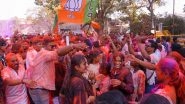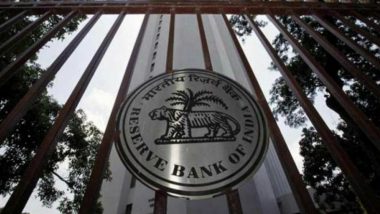Mumbai, December 5: Assuming a normal monsoon in 2019, the Reserve Bank of India (RBI) on Wednesday said that inflation is likely to stay in the range of "2.7-3.2 per cent in H2 of 2018-19 and 3.8-4.2 per cent in H1 of 2019-20, with risks tilted to the upside."
"The projected inflation path remains unchanged after adjusting for the house rent allowance (HRA) impact of Central government employees as this impact dissipates completely from December 2018 onwards," said the RBI in a statement after the bi-monthly meeting of the Monetary Policy Committee (MPC) here. Home, Auto Loan Rates to go Down? RBI Comes up With New Norms For Pricing of Bank Interest Rates.
The MPC, however, reiterated its commitment to achieving the medium-term target for headline inflation of 4 per cent on a durable basis. The next meeting of the MPC is scheduled from February 5 to 7, 2019.
"Although recent food inflation prints have surprised on the downside and prices of petroleum products have softened considerably, it is important to monitor their evolution closely and allow heightened short-term uncertainties to be resolved by incoming data," added the RBI in the statement.
RBI has pegged India's gross domestic product (GDP) growth rate for the financial year of 2018-19 at 7.4 per cent and 7.2 per cent in H2. "Based on an overall assessment, GDP growth for 2018-19 has been projected at 7.4 per cent (7.2-7.3 per cent in H2) as in the October policy, and for H1:2019-20 at 7.5 per cent, with risks somewhat to the downside," said the Central bank.
"Even as inflation projections have been revised downwards significantly and some of the risks pointed out in the last resolution have been mitigated, especially of crude oil prices, several uncertainties still cloud the inflation outlook," said the RBI.
According to RBI, available data suggest that the effect of revision in minimum support prices (MSPs) announced in July on prices has been subdued so far. "However, uncertainty continues about the exact impact of MSP on inflation, going forward," added the Central bank in the statement.
However, the RBI is of the view that "fiscal slippages, if any, at the centre/state levels, will influence the inflation outlook, heighten market volatility and crowd out private investment. Finally, the staggered impact of HRA revision by state governments may push up headline inflation."
The MPC noted that the benign outlook for headline inflation is driven mainly by the unexpected softening of food inflation and collapse in oil prices in a relatively short period of time. "Excluding food items, inflation has remained sticky and elevated, and the output gap remains virtually closed," said the RBI.
"The acceleration in investment activity also bodes well for the medium-term growth potential of the economy. The time is apposite to further strengthen domestic macroeconomic fundamentals. In this context, fiscal discipline is critical to create space for and crowd in private investment activity," said the RBI.
Retail inflation, measured by y-o-y change in consumer price index (CPI), declined from 3.7 per cent in September to 3.3 per cent in October. A large fall in food prices pushed food group into deflation and more than offset the increase in inflation in items excluding food and fuel.
Within the food and beverages group, deflation in vegetables, pulses, and sugar deepened in October. Among other items, there was a broad-based softening across food items, especially cereals, milk, fruits, and prepared meals. Milk and milk products inflation softened caused by surplus supplies in the domestic market.
"Inflation, however, showed an uptick in meat and fish, and non-alcoholic beverages. Inflation in the fuel and light group remained elevated, driven by liquefied petroleum gas prices in October, tracking international petroleum product prices. Kerosene prices also edged up, reflecting the calibrated increase in their administered price," said the RBI.













 Quickly
Quickly


